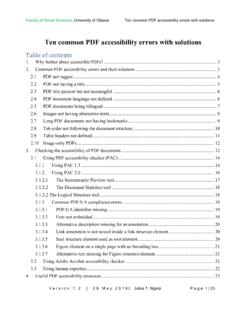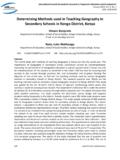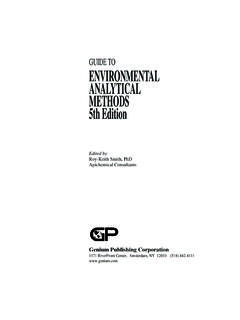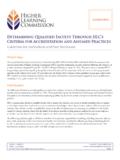Transcription of INTRODUCTION TO INCLUSIVE TEACHING PRACTICES
1 INTRODUCTION . TO INCLUSIVE . TEACHING PRACTICES . Jean-Pascal Beaudoin Centre for University TEACHING , University of Ottawa INCLUSIVE TEACHING PRACTICES | Centre for University TEACHING 1. TEACHING & Learning Support Service, University of Ottawa | v10-2013. Table of Content Table of Content .. 2. INTRODUCTION .. 3. What are INCLUSIVE TEACHING PRACTICES (ITP)? .. 4. Barriers to Learning .. 6. The Role of Educators in Student Success .. 7. Strategies and Tools for INCLUSIVE 8. Strategy 1: Educators Ask Themselves Questions about Goals, Learning Needs and TEACHING Methods .. 8. Strategy 2: Active Learning and Use of a Variety of TEACHING Methods .. 8. Strategy 3: Offer Choices as to How Students Can Demonstrate their Understanding of the Content (Evaluation).
2 9. Strategy 4: Provide Accessible Written or Online Materials in PDF, MS Word, PowerPoint and 10. Tools for Educators: Strategies to support course design and delivery .. 11. Conclusion .. 13. References .. 14. Web Resources .. 15. Endnotes .. 15. INCLUSIVE TEACHING PRACTICES | Centre for University TEACHING 2. TEACHING & Learning Support Service, University of Ottawa | v10-2013. INTRODUCTION As of January 2013, the Government of Ontario requires Universities and Colleges in the province to provide accessibility training i to all educators ii. This requirement is perceived as a great opportunity to discuss best PRACTICES in TEACHING and learning. This introductory document invites educators to reflect on their beliefs and PRACTICES , while being considerate of students' experiences.
3 As well, by combining student engagement and active learning principles, educators can create learning environments which are truly exciting for students from all walks of life. In particular, students with disabilities benefit from the use of a wide variety of TEACHING and learning methods. And because no learners have identical needs, abilities and ways for learning, the use of INCLUSIVE TEACHING in one's classroom will serve well all students in your class. It expands their learning experience, allows for a greater likelihood of success while achieving full potential, and enhances participation to academic life. This document introduces tools illustrating strategies from which to articulate and guide course design and delivery.
4 They should positively influence the professor-student interaction, the syllabus, the TEACHING /learning dynamic and the evaluation process. Also, covered in the next few pages is an overview of what are INCLUSIVE TEACHING PRACTICES , and of barriers to learning and their consequences. INCLUSIVE TEACHING PRACTICES | Centre for University TEACHING 3. TEACHING & Learning Support Service, University of Ottawa | v10-2013. What are INCLUSIVE TEACHING PRACTICES (ITP)? Over the last decade, INCLUSIVE TEACHING has been an emerging concept/field. It is also known, among other things, as Differentiated Learning (mainly K-12 education), Universal Instructional Design or Universal Design of Instruction, and Universal Design for Learning (UDL, ).
5 Each label as a concept has its specifics, but overall addresses similar concerns: the variability of learners' needs, barriers to learning and strategies to overcome impacts. Currently, in higher education, UDL has a strong voice, with its strengths and weaknesses (Vukovic, 2012). Nonetheless, the overarching concept is ITP, rather than UDL, one of the models under INCLUSIVE TEACHING . INCLUSIVE TEACHING embraces diversity in order to meet the varying learning needs and styles of students. It encompasses a broad range of best TEACHING PRACTICES that, used properly, changes the perspective on TEACHING students from a more reactive approach (often teacher-centered), to a more proactive approach (more student-centered).
6 Also, ITP supports the current change in roles for educators, from information provider ( lecturing) to guide and facilitator to learning ( active learning). (Shaw, 2011; Barkley, 2010; Bowman, 2010; Cameron 2010/1999;. Edyburn, 2010; Shaw, 2010, 2011; Gross-Davis, 2009; McGuire&all, 2006; Moses&Chang, 2006; Hatfield, 2003). Diversity refers to individuals with specific characteristics like communication skills, culture, marital status, ability to attend, learning abilities, intelligence, interests, (cognitive abilities), values, culture, social skills, family support, learning styles, age, socioeconomic status, religious beliefs, sexual orientation, ethnicity, physical abilities, sensory abilities, race, gender.
7 (Burgstahler & Cory, 2008, ). Accessibility relates to the removal of one or many barriers, whether systemic, environmental, behavioral, personal, etc., that allows for an individual to reach its full potential while participating in significant occupations, in his/her life;. and contributing to society. Dr. Todd Rose from Harvard's Graduate School of Education and Project Variability (video at , 2012), when speaking about the concept of variability, states that the fields of neurosciences and education recognize that all brains are not alike and therefore students don't all learn the same way. Dr. Rose continues his debunking of the myth of the average learner by stating that variability is the rule, not the exception.
8 Accordingly, varying methods of instruction are essential in reaching as many people as possible and in fostering optimal learning. For students with disabilities, INCLUSIVE TEACHING PRACTICES aim at minimizing the consequences of functional limitations and at removing barriers to learning. For them, inclusion is really about creating accessible learning environment by planning ahead for a variety of learning needs instead of reacting to a few expressed needs. By using INCLUSIVE TEACHING PRACTICES (social model of disability) when updating or developing a course, educators significantly decrease the number of accommodations required (medical model of disability), and because not all students declare their disability or qualify for Student Access Services, they help all students in their class: A better designed course leads to more understanding, better performance and more satisfied students (COU, 2012; Vukovic, 2012; uOttawa-SASS, 2010; Burgstahler & Cory, 2008).
9 INCLUSIVE TEACHING PRACTICES | Centre for University TEACHING 4. TEACHING & Learning Support Service, University of Ottawa | v10-2013. Small changes can make a huge difference: A key realization (is) that small changes could have an important impact. Faculty who initially (feel) overwhelmed by the prospect of redesigning their whole course structure (become) enthusiastic about making small revisions based on ( INCLUSIVE TEACHING ) principles within the context of their own course content and TEACHING styles. (Burgstahler & Cory, 2008, ). Educators may start from their current PRACTICES and strategies and add a few changes at a time, respecting their own pace, with the resources at their disposal.
10 Organizing their TEACHING to vary the ways that the material is conveyed optimize student learning. And finally, inclusion is also about embracing a reflective practice and a welcoming attitude, in addition to varying TEACHING methods, to provide all students with engaging, challenging and relevant learning activities (active learning iii) in a cognitively, emotionally and physically safe and barrier free environment (Vukovic, 2012; Lombardi & Murray, 2011; Milligan, 2010). INCLUSIVE TEACHING PRACTICES | Centre for University TEACHING 5. TEACHING & Learning Support Service, University of Ottawa | v10-2013. Barriers to Learning Students in their diverse background in general, and more specifically with disabilities, may encounter barriers to learning.









